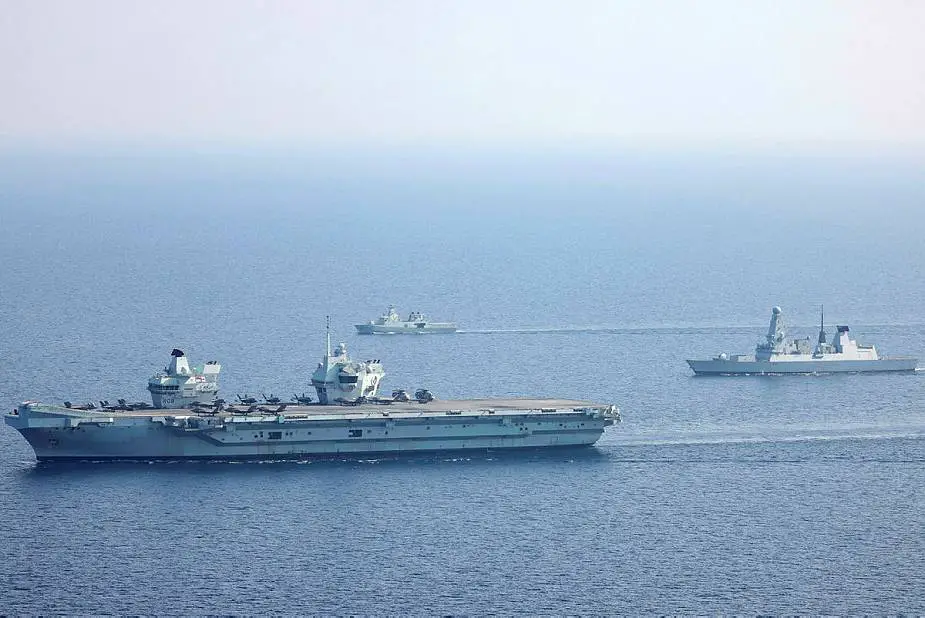According to information released by BAE Systems, the British Navy aircraft carrier HMS Queen is equipped with the latest generation of wastewater treatment systems. The Elizabeth entered service into the Royal Navy in December 2017. The ship has gone above and beyond statutory compliance, with extra commitment to environmental protection demonstrated by installing a treatment plant that is capable of gathering and treating all wastewater prior to storage or discharge.
Follow Navy Recognition on Google News at this link
 EXERCISE ENDURING FRIENDSHIP Pictured: From left to right are HMS Queen Elizabeth, RNOV Seeb, HMS Diamond. (Picture source British Navy)
EXERCISE ENDURING FRIENDSHIP Pictured: From left to right are HMS Queen Elizabeth, RNOV Seeb, HMS Diamond. (Picture source British Navy)
The Queen Elizabeth Class Aircraft Carriers are the largest warships ever constructed in the UK and were delivered by the Aircraft Carrier Alliance, a unique partnering relationship between BAE Systems, Babcock, Thales and the UK Ministry of Defence.
The initial outline design was developed under competition and the detailed system design was undertaken within the alliance. The class is two vessels, HMS Queen Elizabeth and HMS Prince of Wales. Three times the size of the Invincible Class Aircraft Carriers, these huge ships use the latest technology and equipment, enabling them to operate with a streamlined crew of 679, roughly the same complement without air crew as the previous carriers. The intent of the design was to utilise technology where possible to improve operability, reduce through life cost and reduce the manpower loading through life.
Wastewater can be divided into two categories; black water and grey water. Black water is waste generated from toilets, as well as drainage of the medical dispensary and sickbay via wash basins and washtubs. It can contain pollutants including nutrients, metals, toxins and pathogens, which can negatively affect the quality of the sea water and aquatic ecosystems, as well as present risks to human health.
In addition, waste from the galleys (ship’s kitchens) is collected independently and separated into food waste (then dried), grease (then stored prior to further treatment) and residual grey water which is passed through the grey water system.
Grey water includes wastewater from showers, sinks and laundry, which can contain nitrates, phosphates, antibiotics and other chemicals. Like black water, grey water discharge into the sea can contribute to marine pollution and strips oxygen from the water, making survival for marine organisms in these areas extremely difficult.
Most legislation focuses on the treatment of black water and, although there are a few exceptions, grey water is not yet covered by legislation. As well as being the right thing to do, HMS Queen Elizabeth’s grey water treatment system future proofs the ship for any change to grey water environmental regulations to come and therefore ensures that she retains access to areas subject to restrictions now and in the future.
By integrating a treatment plant that can treat both grey and black water, HMS Queen Elizabeth not only demonstrates compliance with international maritime legislation, but she also achieved an optional Lloyds Register Notation Grey Water (G) Character, which demonstrates enhanced environmental protection for operations anywhere around the world.
Whilst it was a challenge to route drains through the ship from multiple sources and ensure contaminations from oils and greases would not impact the performance of the integrated treatment plant, this challenge was met by a talented design team. Both the grey and black water systems achieved performance characteristics and acceptance.
What are the other benefits of this treatment system? Treating grey water on the ship prior to discharge reduces the detrimental effects on marine life and water quality. It eliminates harmful pathogens being introduced into the ocean and fisheries. As other vessels adopt this type of system, over time it should also help to improve the visual quality of coastlines, which in turn could have a positive impact on visitor enjoyment and tourism.



